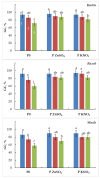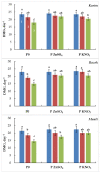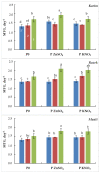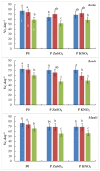Potential of Seed Halopriming in the Mitigation of Salinity Stress during Germination and Seedling Establishment in Durum Wheat (Triticum durum Desf.)
- PMID: 38202374
- PMCID: PMC10780596
- DOI: 10.3390/plants13010066
Potential of Seed Halopriming in the Mitigation of Salinity Stress during Germination and Seedling Establishment in Durum Wheat (Triticum durum Desf.)
Abstract
The salinity of soils and irrigation water is among the main factors that limit plant productivity worldwide. Several alternatives have been proposed to get around this problem. However, these alternatives have faced difficulties in their implementation. As an alternative, the adverse effects of salinity on crop yield can be minimized by selecting species and varieties better adapted to salinity and/or by finding priming agents that give plants a certain tolerance during the vegetative and reproductive stages. The latter are strictly dependent on germination and seedling establishment. For this purpose, a laboratory experiment was conducted on three Tunisian wheat cultivars (Karim, Razeg, and Maali) subjected to moderate salinity stress (MSS, 5 g L-1 NaCl), severe salinity stress (SSS, 10 g L-1 NaCl), or control (0 NaCl) after soaking the seeds in a solution of KNO3 or ZnSO4 (0.5 g L-1). Salinity stress significantly decreased germination capacity (GC) and induced osmotic stress under MSS, which declined under SSS in favor of toxic stress. Pretreatment of seeds with KNO3 or ZnSO4 alleviated the toxic effect, and seedlings recovered initial vigor and GC even under SSS. The Karim cultivar showed better tolerance to salinity and a higher ability to react to priming agents. The calculated sensitivity tolerance index (STI) based on germination capacity, seedling growth, and initial vigor decreased in all cultivars under salt stress; however, this parameter clearly discriminated the studied cultivars. Karim was the most tolerant as compared to Razeg and Maali. We conclude that halopriming provides a benefit by alleviating the harmful effects of salt toxicity and that cultivars differ in their response to priming and extent of salt stress. KNO3 and ZnSO4 effectively alleviated the inhibitory effect of salt stress on seed germination and seedling establishment while significantly improving initial vigor.
Keywords: initial vigor; osmotic effect; seed pretreatment; seedling emergence; stress tolerance index; toxic effect.
Conflict of interest statement
The authors declare no conflicts of interest.
Figures









Similar articles
-
Seed priming by sodium nitroprusside improves salt tolerance in wheat (Triticum aestivum L.) by enhancing physiological and biochemical parameters.Plant Physiol Biochem. 2017 Oct;119:50-58. doi: 10.1016/j.plaphy.2017.08.010. Epub 2017 Aug 18. Plant Physiol Biochem. 2017. PMID: 28843888
-
Seed Halopriming Improves Salinity Tolerance of Some Rice Cultivars During Seedling Stage.Bot Stud. 2022 Jul 25;63(1):24. doi: 10.1186/s40529-022-00354-9. Bot Stud. 2022. PMID: 35877013 Free PMC article.
-
Seed priming and abiotic stress tolerance in carrot: Unraveling the mechanisms of improved germination.PLoS One. 2025 Feb 7;20(2):e0318753. doi: 10.1371/journal.pone.0318753. eCollection 2025. PLoS One. 2025. PMID: 39919063 Free PMC article.
-
Seed priming to alleviate salinity stress in germinating seeds.J Plant Physiol. 2016 Mar 15;192:38-46. doi: 10.1016/j.jplph.2015.12.011. Epub 2016 Jan 16. J Plant Physiol. 2016. PMID: 26812088 Review.
-
Seed priming as a cost effective technique for developing plants with cross tolerance to salinity stress.Plant Physiol Biochem. 2021 May;162:247-257. doi: 10.1016/j.plaphy.2021.02.034. Epub 2021 Feb 26. Plant Physiol Biochem. 2021. PMID: 33711718 Review.
Cited by
-
Putting Biochar in Action: A Black Gold for Efficient Mitigation of Salinity Stress in Plants. Review and Future Directions.ACS Omega. 2024 Apr 29;9(29):31237-31253. doi: 10.1021/acsomega.3c07921. eCollection 2024 Jul 23. ACS Omega. 2024. PMID: 39072056 Free PMC article. Review.
-
Codium fragile (Suringar) Hariot as Biostimulant Agent to Alleviate Salt Stress in Durum Wheat: Preliminary Results from Germination Trials.Plants (Basel). 2024 Jan 18;13(2):283. doi: 10.3390/plants13020283. Plants (Basel). 2024. PMID: 38256836 Free PMC article.
References
-
- Tanji K.K. Nature and extent of agricultural salinity. In: Tanji K.K., editor. Agricultural Salinity Assessment and Management. American Society of Civil Engineers; New York, NY, USA: 2012. ASCE Manual No. 71. Chapter 1.
-
- Abdelly C., Öztürk M., Ashraf M., Grignon C. Biosaline Agriculture and High Salinity Tolerance. Birkhäuser; Basel, Switzerland: 2008. - DOI
-
- Benidire L., Daoui K., Fatemi Z.A., Achouak W., Bouarab L., Oufdou K. Effect of salt stress on germination and seedling of Vicia faba L.) J. Mater. Environ. Sci. 2015;6:840–851.
Grants and funding
LinkOut - more resources
Full Text Sources
Research Materials
Miscellaneous

